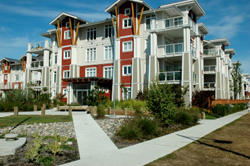A Future Without Houses

Periodically, we are reminded that the average Northern European -- while living every bit as comfortably as the average North American -- consumes only about one half of the petroleum fuels that we do. People pointing this out then often refer to the smaller, more fuel efficient cars used in Europe, and to Europe's generally superior urban mass transit systems, in suggesting an explanation.
There is, however, a far more basic reason: The average European lives in a multifamily dwelling in close proximity to his work, whereas nowhere else but in North America has there developed anything akin to our mania for the unending building of detached single family houses.
Consider, briefly, the enormous price we are paying for our fixation on houses:
- Houses keep population densities too low to support effective mass transit, thereby forcing house owners to commute with gas guzzling vehicles over ever greater distance and along ever more congested, air-polluted and potholed freeways, dodging trucks and road ragers.
- Most authorities still agree that automobiles and light trucks are the single largest source of air pollution; and no major manufacturer has yet promised to market a practical automobile powered by nonpolluting means.
- Individual houses, with their many openings to the outside, are hard to insulate and thus require excessive energy in being kept shielded from outside temperatures.
- The interiors of houses set atop on-the-ground slab foundations might be the best place for toxic Black Mold to grow.
- And, because most North American cities germinated in fertile farming areas, the rambling sprawl of suburbs gobbles up scarce prime farmland.